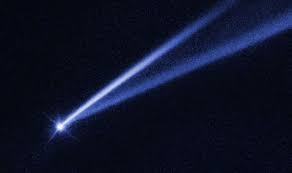Self-destructing asteroid captured by Hubble Telescope

Washington: Hubble Space Telescope and other observatories have captured a self-destructing asteroid spinning so fast that it throws off material.
The U.S. space agency NASA said that images from Hubble showed two narrow, comet-like tails of dusty debris streaming from a 4-kilometer-wide asteroid called Gault.
Each tail represents an episode in which the asteroid gently shed its material, revealing that Gault is beginning to come apart, according to the observation.
When sunlight heats an asteroid, the infrared radiation that escapes from its warmed surface carries off both heat and momentum, which creates a small force that can cause the asteroid to spin faster, according to the study to be published in the Astrophysical Journal Letters.
When this centrifugal force eventually overcomes gravity, the asteroid becomes unstable and landslides on the object can release rubble and dust into space, leaving behind a tail of debris.
Watching an asteroid become unglued gives astronomers the opportunity to study the makeup of these space rocks without sending a spacecraft to sample them.
“We just had to look at the image of the streamers, and we can see all of the dust grains well-sorted by size,” said Olivier Hainaut of the European Southern Observatory in Germany.
“All the large grains (about the size of sand particles) are close to the object and the smallest grains (about the size of flour grains) are the farthest away because they are being pushed fastest by pressure from sunlight,” said Hainaut, a member of the Gault observing team.
The asteroid’s narrow streamers suggested that the dust was released in short bursts, lasting anywhere from a few hours to a few days. The tails will begin fading away in a few months as the dust disperses into interplanetary space, according to the study.





